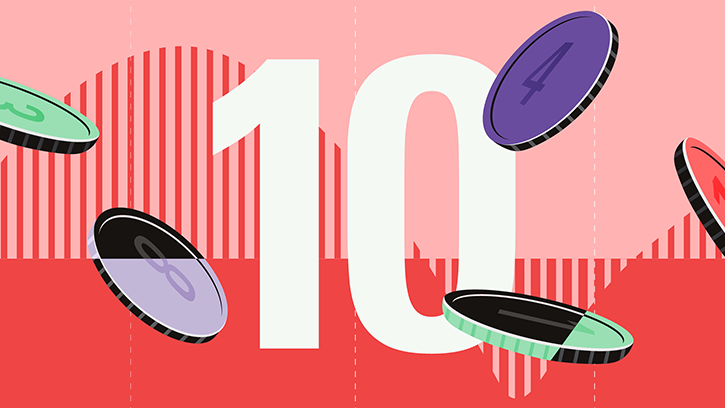
If all goes as the market expects, the Federal Reserve is less than a week away from cutting interest rates for the first time since the onset of the covid pandemic. Though the move is widely anticipated, its effects will likely play out across the markets for some time.
With inflationary pressures finally easing from their recent 40-year highs, investors expect the central bank to reduce the target federal-funds rate by at least a quarter of a percentage point from the current range of 5.25%-5.50%. More recently, investors have been debating the likelihood of a half-point cut. That would be a more aggressive move than markets expected a few months ago. A bigger unknown is how these rate cuts will play out for investors.
How Do Stocks Perform When the Fed Cuts Rates?
Conventional wisdom says stocks tend to do well after interest rate cuts. The Fed lowers rates to stimulate the economy by making borrowing cheaper for businesses and consumers, which tends to be constructive for equities. That’s certainly true some of the time. But strategists say investors looking for a playbook for an easing cycle should take a more nuanced view. That’s especially true in today’s unusual environment, which is still working its way out of pandemic-era distortions and is dominated by high-flying tech stocks. "Every cycle is different," says Jeff Buchbinder, chief equity strategist at LPL Financial.
The last four major rate-cutting cycles show why it’s challenging to draw sweeping conclusions. Market performance can vary dramatically in the year after a new easing cycle starts. The Morningstar US Market Index rose more than 21% in the 12 months following the beginning of the Fed’s 1995 easing cycle, as the economy achieved a rare soft landing. But returns cratered more than 10% when the Fed began cutting rates in 2001 as the dot-com bubble burst.
"Many investors think there is some sort of Fed rate cut playbook," says Denise Chisholm, director of quantitative market strategy at Fidelity. "But it doesn’t really exist."
The Fed's 'Why' Matters
Underlying the wildly different years are different market fundamentals and Fed attitudes. The market will react differently if it perceives the central bank as confident and in control – engineering a soft landing for the economy – versus if it thinks the bank is being reactionary, slashing rates amid the threat of recession.
To understand what the next year may look like, "you need to think about why the Fed is cutting rates," says Lara Castleton, US head of portfolio construction and strategy at Janus Henderson Investors.
Adding to the challenge is a limited historical playbook. There are not many instances going back to the 1960s, says Chisholm, "so you don’t have a lot of robust data to evaluate."
Roughly half the time, Chisholm explains, the Fed has started easing policy because it felt the economy was heading for a recession. In the other cases, it reduced rates to recalibrate monetary policy (what some call a "maintenance cut"), rather than in response to an economic threat.
Look to Earnings Growth
Rate changes don’t tell the whole story. Chisholm says earnings are a more reliable predictor of future stock market returns. When earnings growth is positive and accelerating and rates are falling, "that’s a positive for the market over the next 12 months," she says. According to her analysis, when that happens, the stock market as measured by the S&P 500 returns an average of 14% over that time, compared with a baseline average of 11% when rates fall and just 7% when earnings growth falls along with rates. After the second-quarter earnings season, firms in the Morningstar US Market Index saw more than 10% annual earnings growth on average.
Chisholm says a larger differential between the target federal funds rate and the inflation rate is another good indicator of strong market returns. Restrictive rates combined with lower inflation signal that the Fed has more room to reduce rates if need be, which tends to be constructive for stocks. There’s currently an unusually large gap between the federal funds rate and the inflation rate.
Prepare for Market Volatility
As always, no one has a crystal ball for the markets. Even amid encouraging data, stocks move on sentiment.
"As the Fed starts its cutting cycle, markets are still going to worry," says Buchbinder. "The economy is slowing, and the Fed is cutting … you’ve got slow growth and contained inflation." Amid two cooler-than-expected jobs reports, investors are grappling with whether the central bank has waited too long to cut rates and opened the door to a recession.
Buchbinder adds that much of the upside of the upcoming rate-cutting cycle has already been priced into the stock market, which has gained more than 24% over the past 12 months. "The market has benefited from [imminent rate cuts] already, and so further gains could be limited," he says. But on the other hand, a true soft landing for the economy could present even more upside for stocks.
It won’t be immediately clear which scenario comes to pass. Buchbinder expects it to be litigated in the market for the next few months. "This is why you get volatility around these inflection points and policy changes," he says. "They just increase uncertainty."
Investors Can Prepare for Both Outcomes
Castleton suggests equity investors position for both scenarios at the margins of their core holdings. While a soft landing is still the base case for many analysts and economists, slowing labor market data over the past two months has sent an undeniably bearish signal. "It’s impossible to tell whether the Fed was too late, whether we’re going to have a hard landing or a soft landing," she says.
She suggests investors look to defensive stocks and REITs, which are sensitive to falling rates, as ballast for portfolios in case of a major economic slowdown. Chisholm also sees opportunity in rate-sensitive sectors like financials and real estate, which she says have not fully priced in the impact of Fed cuts as they usually do. "Those sectors have underperformed quite dramatically over the last year," she says.
Both Castleton and Chisholm suggest investors consider smaller-cap stocks, which have struggled in recent years but could break out during a soft landing. If the economy is still strong, "small caps are one of the areas that will definitely outperform, even if they come with higher volatility," Castleton explains.
Chisholm adds that valuations are also on investors’ side, as mega-cap tech companies have become more expensive this year.




























